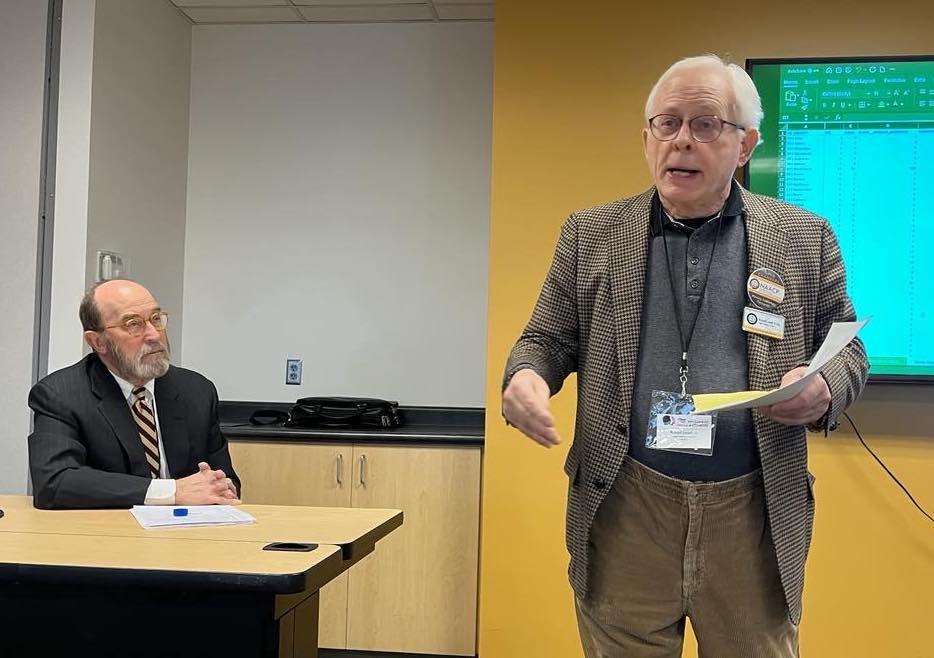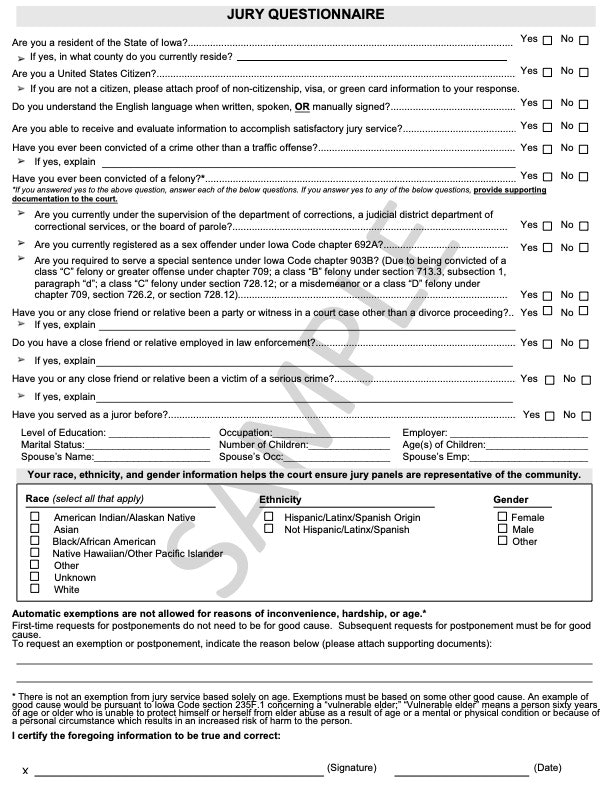Five of the eight Iowa counties with the largest Black populations “had trial juries that were fully representative of their jury-eligible Black population” during 2022 and the first half of 2023, according to data analyzed by the Iowa-Nebraska NAACP. However, trial juries in Polk County and Scott County failed to hit that benchmark, and Dubuque County was “particularly problematic,” with zero Black members of any trial jury during the eighteen-month period reviewed.
The same review indicated that trial juries in Linn and Woodbury counties were close to being representative of the area’s jury-eligible Latino population, while Latinos were underrepresented on juries in Johnson, Marshall, Scott, and Polk counties, and particularly in Muscatine County.
Russell Lovell and David Walker, retired Drake Law School professors who co-chair the Iowa-Nebraska NAACP Legal Redress Committee, examined juror data provided by the Iowa Judicial Branch and presented their findings at the 11th Annual Iowa Summit on Justice and Disparities in Ankeny on November 3.

David Walker (left) watches as Russell Lovell speaks at the Iowa Summit on Justice and Disparities
DIVERSITY MATTERS FOR RIGHT TO “IMPARTIAL JURY”
The Sixth Amendment to the U.S. Constitution and Article I, Section 10 of Iowa’s constitution grant criminal defendants the right to “a speedy and public trial” by “an impartial jury.” The U.S. Supreme Court has interpreted that language to mean jury pools and jury panels from which a trial jury is drawn must represent a “fair cross-section” of the community served by the trial court, so that no distinctive group is underrepresented.
Studies have long shown that all-white juries are more likely to convict Black defendants than white defendants, and that diverse juries are better at fact-finding and deliberation, due to a wider range of life experiences. Juries reflecting the communities they serve are also less likely to be influenced by overt or implicit bias.
Another benefit: a diverse jury “allays the apprehension of prejudice” or bias and therefore promotes the appearance of justice, Walker observed during the November 3 presentation.
Lovell added that although only about 5 percent of criminal cases go to trial, the NAACP is “absolutely convinced that the problem of a lack of diversity on jury pools affects every single case involving African Americans or Latinos.” That’s because defendants (even if innocent) may agree to a plea bargain, perhaps with harsh terms, for fear of going to trial before an all-white jury, which could be more likely to convict or approve a lengthy sentence.
A LEGAL BREAKTHROUGH
Landmark U.S. Supreme Court cases on the right to representative juries include Taylor v Louisiana, decided in 1975, and Duren v Missouri (1977). The most important Iowa Supreme Court case was State v Plain, a unanimous 2017 decision authored by Justice Daryl Hecht.
The Plain court reversed a 1992 Iowa Supreme Court precedent (State v Jones), which had held that to prove a fair cross-section claim, defendants had to show at least a 10 percent disparity between the general population of the county and the group’s percentage of the jury pool. That was an impossible task for Black Iowans, because there was no county where African Americans comprised 10 percent of the population.
That 1992 case “was wrong the day it was decided,” Lovell asserted at the justice summit. “But that was the law,” so Iowa attorneys mostly stopped attempting to raise claims about unrepresentative juries.
The Plain decision “sent a whole new message,” Lovell said. First, because the case relied on the impartial jury clause of Sixth Amendment, the court found defendants need not prove “intentional exclusion of protected minority groups,” as would be required for a successful Fourteenth Amendment equal protection claim. The Sixth Amendment “guarantees that minority groups will not be systematically excluded, even where there is no evidence of intentional exclusion,” Justice Hecht wrote for the court.
The Plain decision also confirmed defendants had the right to access Iowa jury records and data, so attorneys could demonstrate juries in a given area did not adequately represent the diversity of the population. Walker noted that Iowa is “way ahead” of many other states in this regard. By way of comparison, demographic data on jurors is considered confidential in Nebraska and therefore not available to criminal defendants.
In another notable passage from Plain, the Iowa Supreme Court held, “We strongly encourage district courts to be proactive about addressing implicit bias.” Three justices (David Wiggins, Brent Appel, and then Chief Justice Mark Cady) would have gone further and required trial court judges to give a jury instruction on implicit bias.
HOW TO MEASURE REPRESENTATIVE JURIES?
In a 2019 case known as State v Lilly, the Iowa Supreme Court established a way to determine whether a jury had been drawn from a fair cross-section of the community. Justice Edward Mansfield wrote for the 4-3 majority, which relied on Article I, Section 10 of the Iowa Constitution, rather than copying how the U.S. Supreme Court had interpreted the Sixth Amendment.
Justice Mansfield’s opinion called for using “accepted statistical methods” to calculate “the probability that the disparity between a group’s jury-eligible population and the group’s percentage in the qualified jury pool is attributable to random chance.”
The Lilly majority further held that “the threshold should be one standard deviation—in other words, the percentage of the group in the jury pool must be one standard deviation or more below its percentage in the overall population of eligible jurors.” That means there’s a roughly 84 percent chance the disparity didn’t occur by chance. Iowa’s bar is easier to clear than the standard the U.S. Supreme Court has set for fair cross section claims under the Sixth Amendment (two standard deviations, or a 95 percent probability the disparity didn’t occur by chance).
Under Lilly, Iowa defendants are also required to “trace the disparity to some practice or practices” that led to a group being systematically excluded. But showing negligence in jury operations (as opposed to intentional discrimination) could suffice, Justice Mansfield wrote: “we hold today that run-of-the-mill jury management practices such as the updating of address lists, the granting of excuses, and the enforcement of jury summonses can support a systematic exclusion claim where the evidence shows one or more of those practices have produced underrepresentation of a minority group.”
Finally, the Lilly majority called for using current U.S. Census data to calculate the percentage of Blacks or Latinos in a county’s jury-eligible population (adults who are U.S. citizens and not barred from service due to a criminal record).
IMPROVING PROCEDURES AND DATA QUALITY
The Iowa-Nebraska NAACP’s Legal Redress Committee began extensive work on representative juries around 2014. In addition to filing amicus briefs in Plain, Lilly, and other Supreme Court cases, Lovell, Walker, and Iowa-Nebraska NAACP President Betty Andrews worked with court administrators and Iowa Supreme Court justices to improve rules and procedures related to jury selection. Lovell served on a Committee on Jury Selection, appointed by the Iowa Supreme Court, which in 2018 published its recommendations “to ensure the makeup of jury pools in Iowa represent a fair cross-section of the community.”
Lovell explained at the November 3 summit how non-public parts of the administrative process can skew jury pools. For example, in many jurisdictions, judicial staff use databases of registered voters or citizens with driver’s licenses to generate the names of people summoned to appear for jury service. But people with non-operator IDs were not always entered into the system, even though a study in Nebraska found Black people made up a higher percentage of residents with non-operator IDs than those with driver’s licenses.
Some court administrators were not using the U.S. Postal Service’s change of address system to confirm they had current contact information. People from underrepresented groups are more likely to change residences, putting them at higher risk of missing a jury summons.
The Iowa judicial branch was not consistently collecting data on the race and ethnicity of people who served on juries. So the NAACP successfully advocated for making that part of the juror questionnaire mandatory, and making the questionnaire available electronically to increase completion rates.
The NAACP also worked to help Iowans with criminal records regain the right to serve on a jury. Even after Governor Kim Reynolds’ August 2020 executive order restoring voting rights to most Iowans who had completed their sentence after a felony conviction, judicial branch rules still permanently barred those people from jury service. But Iowa Supreme Court Chief Justice Susan Christensen signed an order in early 2021 to amend the state’s rules of criminal and civil procedure, so that Iowans who have discharged most kinds of felony sentences became eligible to serve on juries. The NAACP estimates 150,000 to 160,000 Iowans (who are disproportionately people of color) could be affected by that rule change.
Unfortunately, that reform may not be mitigating racial disparities as much as it could be, Lovell said during the November 3 presentation. The latest version of Iowa’s questionnaire for prospective jurors, amended just this year, includes detailed questions about past criminal convictions but lacks a box people can check to indicate their rights have been restored.

Lovell said he and Walker were “flabbergasted” Iowa’s revised questionnaire does not include such a box (which exists on the federal jury questionnaire). That could be “intimidating” and could discourage someone with a criminal record from attempting to serve on a jury. That alone could make juries less representative, because of longstanding racial disparities in Iowa’s justice system. Lovell confirmed to Bleeding Heartland that judicial branch staff did not ask the NAACP to review a draft before finalizing the new questionnaire.
The Plain and Lilly decisions laid out a path for pursuing claims about unrepresentative juries, but those statistical methods rely on having access to accurate numbers. At the NAACP’s request, Iowa’s State Census Coordinator Gary Krob created pages on the Iowa Data Center website where the public can easily find demographics (such as race, ethnicity, gender, and U.S. citizenship) for the jury-eligible population in all 99 counties.
Iowa’s State Court Administrator Bob Gast has also provided anonymized demographic information to the NAACP on members of jury pools (people who are eligible to serve and report to a courthouse in response to a jury summons), jury panels (the “group of prospective qualified jurors who are sent to a courtroom for jury selection”), and those selected as jurors for a trial.
WHERE DOES IOWA HAVE REPRESENTATIVE JURIES?
Newly available data allow advocates for fair justice systems to calculate whether juries in any Iowa county adequately reflect the area’s demographics. Lovell and Walker wondered, “Has there been improvement in the racial diversity of Iowa’s juries as a result of the Plain/Lilly decisions and NAACP advocacy?”
For their presentation to the justice summit, they focused on Black jury representation in eight counties: Polk (Des Moines metro area), Linn (Cedar Rapids metro), Black Hawk (Waterloo/Cedar Falls), Johnson (Iowa City), Scott (Quad Cities), Des Moines (Burlington), Dubuque, and Woodbury (Sioux City). About three-quarters of Black Iowans live in one of those eight counties, according to estimates from the U.S. Census Bureau’s recent community surveys.
Walker and Lovell reviewed data from an eighteen-month period (all of 2022 and the first six months of 2023), as well as a six-month stretch from January through June 2023 to get a sense of the latest trends.
The good news: in all eight counties, the percentage of Black people on jury pools (those who come to the courthouse in response to a summons) was equal to or slightly higher than the percentage of Black people in the jury-eligible population. That was true over the longer and shorter periods studied.
In five counties with large Black populations—Black Hawk, Des Moines, Johnson, Linn, and Woodbury—the percentages of Black trial jurors were “exactly where they should be,” Lovell said. He called that “really significant progress.”
But in some counties, there was a significant drop-off in diversity from the jury pools to the jury panels (those sent to the courtroom for jury selection) and another drop-off for the trial jury members.
The most glaring disparity was in Dubuque County, where not a single Black person served on a trial jury during all of 2022 and the first six months of this year, “though there were 344 Blacks in the jury pools and 19 Blacks on jury panels.”
Black Hawk, Linn, and Scott counties had “worrisome” declines in the percentage of Black people from their jury pools to panels. However, the NAACP’s analysis shows that trial juries in Black Hawk and Linn were still representative during the period studied, which “was not the case in Scott County.”
The NAACP is concerned about the trend lines in Polk County. During the most recent six months for which data is available, the percentage of Black jurors in Iowa’s largest county was noticeably lower than it had been during 2022. Lovell said he had alerted Polk County Attorney Kimberly Graham about those numbers following her remarks to the Iowa Justice Summit earlier on November 3.
Spreadsheets provided by the state court administrator also revealed that the percentage of Blacks who were excused from serving on Polk County juries increased from 2022 to the first half of 2023. So did the percentage of Blacks whom prosecutors struck during jury selection.
Such numbers merit further study, and the NAACP hopes grassroots advocates across Iowa will review jury statistics for their own counties. “If it looks like there’s a problem, there’s no reason you can’t talk to the chief judge” for the judicial district, or ask the jury manager for an explanation, Lovell said.
Lovell and Walker had less complete data on Latino jurors in Iowa, but their preliminary look at seven counties with significant Latino populations showed less progress toward representative juries. At first glance, the data appear encouraging: in most of the counties, the percentage of Latinos in the jury pools was equal to or greater than the percentage in the jury-eligible population.
However, the share of Latinos dropped off in most of the studied counties when moving from the pool to the panel, and then to the trial jury.
In Linn and Woodbury, trial juries “were very close to being representative” in 2022 and the first half of 2023. But underrepresentation of Latinos was statistically significant at the one standard deviation level in Johnson, Marshall (Marshalltown area), Polk, and Scott counties.
Muscatine County had the worst disparity on trial juries; the underrepresentation of Latinos was statistically significant at the two standard deviation level.
Walker and Lovell flagged Marshall and Muscatine counties as “good examples of why the NAACP contends the Iowa Supreme Court’s decision in State v. Mong is erroneous.” In that unanimous 2023 opinion authored by Justice Christopher McDonald, the court declined “to extend our fair-cross-section jurisprudence to challenges to the jury panel.” Looking only at the pools, Marshall and Muscatine appear to be doing well on representative juries. But during 2022 and the first half of this year, both counties “showed statistically significant underrepresentation at the jury panel stage and this carried through to the trial jury.”
Lovell said he has reached out to Joe Henry of the League of United Latin American Citizens in Iowa and hopes to collaborate with that organization on reform efforts.

